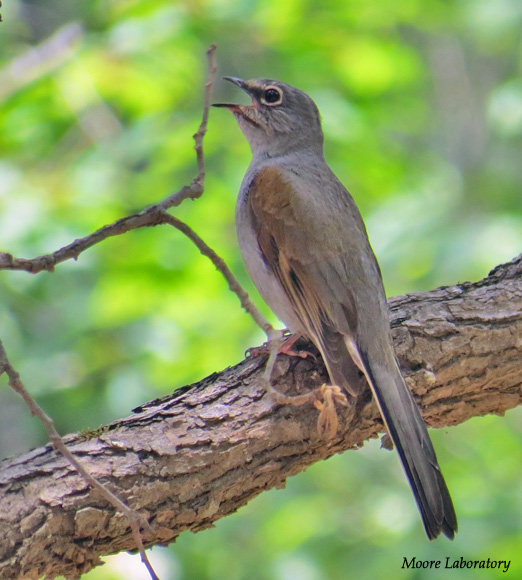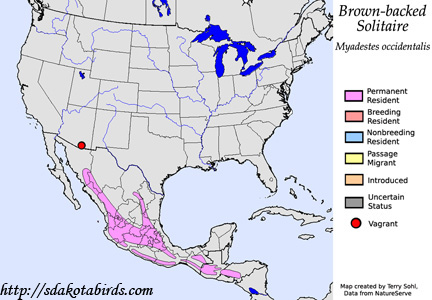| Length: 8 inches | Wingspan: 13 inches | Seasonality: Non-resident in South Dakota |
| ID Keys: Gray overall, brownish wings, obvious eye ring. | ||
 The
Brown-backed Solitaire is a songbird of mountainous regions of Mexico and
Central America. In the United States, the first confirmed sighting of
the bird occurred in 2009 in Miller Canyon, in southern Arizona.
Another bird was identified by sound in Arizona in 2011. Other
sightings of the species have been made before in the United States, but
previous records were generally attributed to escaped birds from captivity.
The
Brown-backed Solitaire is a songbird of mountainous regions of Mexico and
Central America. In the United States, the first confirmed sighting of
the bird occurred in 2009 in Miller Canyon, in southern Arizona.
Another bird was identified by sound in Arizona in 2011. Other
sightings of the species have been made before in the United States, but
previous records were generally attributed to escaped birds from captivity.
Habitat: Found in mixed forest areas in its native range, primarily in mountainous or hilly areas. They are often found in riparian zones in such habitats, and it is riparian zones in canyons where sightings have been made in southern Arizona.
Diet: Feeds on fruits and berries, as well as insects and small invertebrates.
Behavior: Will observe from a perch for a moment before flying out to capture insects in mid-air, or gleaning insects from foliage and vegetation. Foraging may occur at nearly any height, from near the ground to rather high in the forest canopy.
Nesting: The nest is a cup of grasses, mosses, rootlets and other material, placed in a protected location on the ground, such as near a fallen log or by a tree stump. The female lays between 3 and 7 eggs, and she does the majority of the incubation. Eggs hatch after about 2 weeks.
Song: The song is a clear series of notes, increasing in tempo and volume but decreasing in pitch.
Migration: Considered a permanent resident throughout its normal range. However in parts of their range they will move to lower elevation for the winter.
Interactive eBird map: Click here to access an interactive eBird map of Brown-backed Solitaire sightings
Similar Species: Similar in appearance to Townsend's Solitaire, although the brownish wings/back differentiate the species.
Conservation Status: Populations of Brown-backed Solitaire appear to be in decline. However, they are still found over a relatively broad geographic area and overall populations are not considered threatened at this time. The IUCN lists the Brown-backed Solitaire as a species of "Least Concern".
Further Information: 1) BirdLife International - Brown-backed Solitaire
2) iNaturalist.org - Brown-backed Solitaire
3) BirdFellow - Brown-backed Solitaire
Photo Information: Photo taken by Moore Laboratory - June 17th, 2014 - Northeast of Santa Teresa, Nayarit, Mexico - Photo licensed under Creative Commons Attribution 2.0 Generic License
| Click below for a higher-resolution map |
 |
| South Dakota Status: Non-resident in South Dakota |
Additional Brown-backed Solitaire Photos (coming soon!!)
